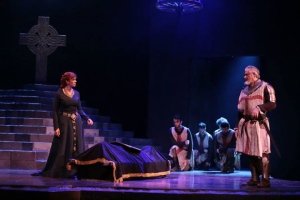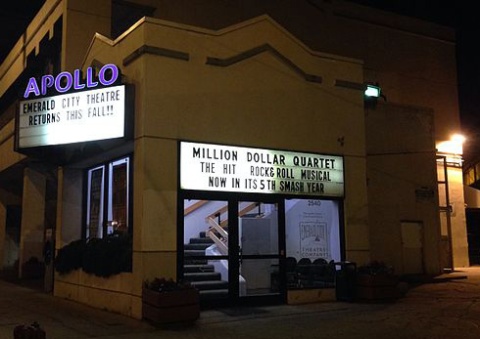Man of La Mancha at the Marriott Theatre in Lincolnshire served up the most moving time I’ve spent in a theatre in a long while.
For those unfamiliar with the show, it’s a play-within-a-play. Miguel de Cervantes, the author of Don Quixote, is arrested and put in a holding cell to await the Inquisition. He waits with his assistant, among those who also wait: if they’re lucky, just to be tried for theft or murder; if unlucky, to be called before the Inquisition. The other prisoners rob Cervantes of his belongings, including a manuscript. To ransom the manuscript, he enlists his fellow prisoners’ aid to present a story which he hopes will convince them to let him keep his manuscript.
In other productions I’ve seen (or performed in), both the outer and the inner play are set in 16th-17th century Spain. For this production, director Nick Bowling (and designers Jeffrey D. Kmiec, Jesse Klug, Nancy Missimi, Robert E. Gilmartin, and Sally Weiss) reimagined the setting of the outer play, presenting the characters as modern—people you could easily imagine populating a present-day holding cell. Since these people had no notion of when they might be allowed their day in court, if ever, the production evoked associations with any justice system that’s arbitrary and unfair. As we know from the news, there are too many people in the world being held unfairly even in our supposedly enlightened age.
You should go. To this production, if you can, though it’s only possible until August 14, 2016. If you can’t attend the Marriott production, your next best bet is probably to listen to a Broadway cast album of the show. Don’t bother with the movie.
The ensemble acting and vocals at the Marriott Lincolnshire were sublime. While I can’t mention everyone, I need to say that for both acting and singing, Nathaniel Stampley, Danni Smith, and Richard Ruiz brought the production to a peak of near-perfection. I think it was the combination of the immediacy (or maybe the timeless feel) of this production and the beautiful vocals that put it over the top for me. I wept like a tiny little girl. In my defense, I was not the only one. I heard sniffles from BK, Sis, Cookie, and Cookie Jr., as well.
There are people who knock the musical as reducing Cervantes’ work too much, or as having too simplistic a message. I can’t speak to the former since I haven’t yet read his novel. As to the latter, I say, “hooey.” Evil remains in the world, and it’s not illusory. We have our work cut out for us. If anything, even a Broadway musical, can give us the courage to face the task, I say revel in it.
And then sally forth.









